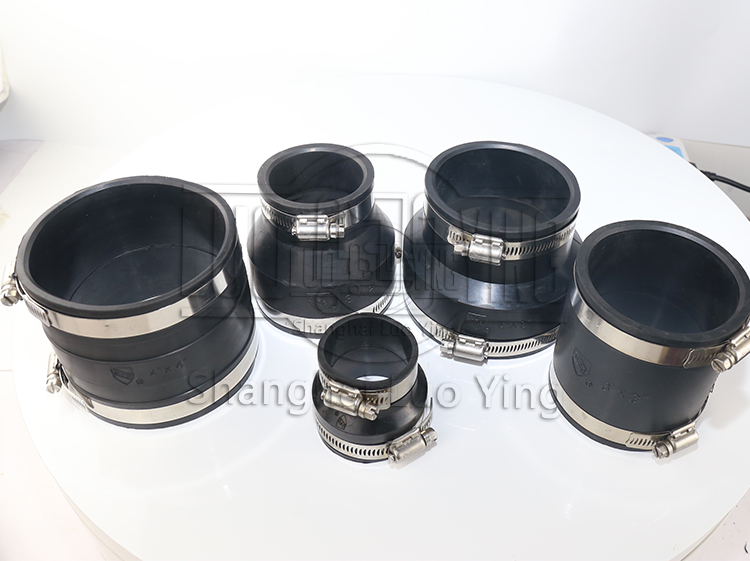The installation of rubber joints is also a factor that affects their life span
Jun-23-01
The installation of rubber joints is also a factor that affects their life spanThere are many names of rubber joints, such as bendable rubber joints, bendable rubber joints, soft rubber joints, soft rubber joints, rubber expansion joints, rubber compensators, rubber shock absorbers, shock absorbing pipes, pipe soft joints, etc. The names are different, but they all refer to this kind of flexible pipe joints with the characteristics of high elasticity, high air tightness, medium resistance, weather resistance, corrosion resistance, acid and alkali resistance, etc. It can not only compensate the running mechanical displacement of pipeline equipment, but also use its own expansion, distortion and deformation ability to compensate the axial, lateral and angular displacement of pipeline equipment caused by thermal expansion and contraction, while absorbing equipment vibration and reducing noise pollution. It is widely used in modern industry.
Rubber joint is generally a complete rubber joint soft connection made of inner and outer rubber layer, compound fabric cord, lined steel wire winding, vulcanized into a ball by high temperature and high pressure mold, and combined with metal flange or parallel joint. It is installed to protect the rubber joint from the danger of pulling off and to control the displacement of the rubber joint within a certain range to ensure the safe and stable operation of the rubber joint and pipeline equipment. Once the pipeline expands too much in operation, it will play a certain restrictive role in ensuring the operation of the pipeline. It is especially suitable for the soft connection of rubber joints with vibration or certain slope and bend in the pipeline. Strictly speaking, when the pipe diameter is larger than DN200, there should be a limit device. This is because the larger the pipe diameter is, the more obvious the puckering performance is. Large-diameter rubber joints can be softly connected by adding a limit device.
Different materials of rubber joints are needed according to different media. Rubber joint rubber materials include natural rubber, EPDM rubber, neoprene, silicone rubber, fluorine rubber, etc. They are heat-resistant, acid-resistant, alkali-resistant, corrosion-resistant, wear-resistant, oil-resistant, etc.

1 . After the rubber joint is pressurized for the first time, it should be re-pressurized to tighten the bolts before restarting after installation test pressure or long-term disuse, and then put into use.
2 . When the pipeline medium is acid, alkali, oil, high temperature and other special materials, it is appropriate to use rubber joints higher than the working pressure of the pipeline.
3 . The interface of the rubber joint should be the valve flange or the flange conforming to GB/T9115.1 (RF).
4 . When the instantaneous pressure of the pipeline is greater than the working pressure, a joint higher than the working pressure should be used.
5 . The normal use medium temperature of rubber joint is 0-60℃ for ordinary water. For special media, such as oil, acid, alkali, high temperature and other corrosive and hard materials, the corresponding rubber joint material should be selected, not blind or general.
6 . For high level water supply or suspended water supply, the pipe should be fixed on the hanger, bracket or anchor frame, the joint should not bear the weight of the pipe itself and axial force, otherwise it should be equipped with rubber joint with anti-pulling device, and its bearing capacity must be greater than the axial force of the pipe.
7 . When flexible rubber joint is used for water pump inlet and outlet, it should be located close to the side of the pump, and metal reducer joint should be installed between the pump and large diameter. Variable diameter.
8 . When the pipeline displacement is greater than or equal to the maximum compensation of the joint, the number of parallel displacement joints should be increased. In order to adjust the tolerance of the pipeline, it is strictly forbidden to put the joint in the state of maximum deflection displacement and deviation, moreover, excessive expansion and contraction, displacement, deflection, etc.
9 . When installing the rubber joint, the screw of the bolt should be extended to the outside of the joint, and the bolt on each flange end face should be tightened repeatedly and evenly with diagonal pressure to prevent bias pressure. The threaded joint should be tightened evenly with a standard wrench. Do not exercise the joint with strong force stick to slip, slip or break. It should be checked regularly to avoid loosening causing dislodgement or water seepage.
10 . The use or storage of rubber joints should avoid high temperature, ozone, oil and acid-alkali environment. Outdoor or sunny pipeline should be built with sun shelf, and exposure to sun, rain and wind erosion are strictly prohibited. It is strictly forbidden to paint or wrap insulating materials on the surface of rubber joints. As the rubber joint products are aging, they should be checked and replaced in time.

